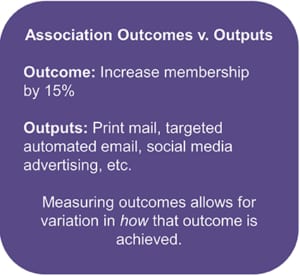In challenging times, when organizations are charged to do more with fewer resources, it’s important to focus on the most important objectives and be ready to pivot as needed. Along with the development and implementation of a strategic plan, it’s also critical to use an agile goal-setting methodology. OKRs (Objectives and Key Results) are one of the most powerful methodologies that can help your organization execute your strategic plan in an inclusive, transparent and collaborative way. My colleague Juan Sanchez, CIO of Inteleos, and I presented on this at ASAE TEC 2020.
What is an OKR?
An OKR is a goal-setting methodology that helps an organization’s teams focus, align and measure their work against outcomes that matter. The concept originated by Andy Grove at Intel in the 1960s and was made popular by John Doerr, a former Intel and Google executive, who published a New York Times bestseller “Measure What Matters”, in 2017. OKRs are used by Google, the Bill and Melinda Gates Foundation and Amazon, among other high-performing organizations.
In considering the key components of OKRs, it’s helpful to think of using a GPS on an exciting road trip:
Objectives — Your Destination
Objectives are the destinations you put into your GPS — where are you going, exactly? They also include a motivational element, the why — why are we taking the trip? The why describes what’s exciting about getting to this destination and is meant to bring excitement and inspiration to your teams.
In the OKR methodology, there are two types of objectives:
Committed objectives are set goals that an individual, team or organization has agreed to reach, no matter what. Resources and time need to be allocated to ensure these objectives are achieved. If they are not reached, a review is needed to find out how to prevent it from happening again. The team is able to clearly measure their success.
Aspirational objectives, sometimes called “moonshots,” are goals that an individual, team or organization hopes to reach. These represent new paths for the organization. The way forward isn’t clear-cut and sometimes the resource commitment isn’t known. At the end of a designated time-period, often quarterly, the team inspects the progress achieved. They then reset or recalibrate to figure out how to continue on the journey.
Key Results (KRs) — Your Waypoints
Key results are the waypoints/steps along the way that show you are making progress towards the destination. To truly benefit from an OKR, KRs should always measure outcomes as opposed to outputs. The difference between these can be difficult to determine but are pivotal for success.
OKR expert Felipe Castro describes how to differentiate between outputs and outcomes: outputs measure activity-based results and outcomes measure value-based results. Another way to put it is, “An output is something you do, an outcome is something that happens as a consequence of something you do,” according to Henrik-Jan van der Pol, CEO, Perdoo.

With outcomes, you aren’t prescribing specifically what needs to be done. Instead, you empower the team to do what it takes to increase something that is meaningful to your organization. It is about measurement and impact. In the case of a road trip, the key results include waypoints such as passing a historic building or a sign that marks “100 miles to destination.”
Initiatives — The Background Preparation
Initiatives are tasks or projects that are necessary to complete the objectives. In the road trip analogy, the initiatives might include filling the gas tank, packing the car or even buying the car in the first place.
How do OKRs help associations?
- They encourage stretching for “moonshots” (aspirational) versus “roofshots.” Not only is it acceptable but expected that not all objectives will be fully achieved. OKRs are meant to be ambitious and encourage room for innovation and growth.
- They encourage collaborative alignment vs. top-down alignment. Since OKRs are most often achieved by teams rather than by individuals, collaboration is key. It starts with writing OKRs collaboratively across the traditional organizational hierarchy, then working together through various checkpoints to ensure alignment. This is a key differentiator of OKRs compared to other methodologies.
- They accept a fast rate of change and accommodate for it. Teams need to be agile and adaptable, and so do the methods that support them, but organizational adaptability is often a challenge for associations. This is why frequent (weekly, monthly, quarterly) check-ins are a must for OKRs to monitor progress, encourage rapid learning, and provide room for adjustments or pivots as needed in a timely manner.
How to get started at your association
The first step to getting started is making the commitment to apply a performance management methodology through a set period. This can begin with just one team committing to OKRs and sharing their experience with the rest of the organization. You can track your association’s objectives and key results using a simple spreadsheet or document, or build out a dashboard/scorecard utilizing a digital system/software solution, such as Asana, Gtmhub, Perdoo or Airtable, to name a few.
Ninety percent of companies fail to achieve the goals they set for themselves. Whether you use OKRs or another goal-setting method, it is vital that you don’t just set and forget your objectives. Build a healthy habit of checking in and updating them frequently to optimize your results.
OKR Best Practices
As you get started, keep these best practices in mind:
- Set a maximum of three OKRs per period to keep the process manageable for your team
- Ensure OKRs are transparent throughout your organization
- Aim for a success rate of 70% — not 100%, since aspirational OKRs are included
- Create OKRs quarterly
- Review weekly
- Adjust monthly
- Retrospectively review at the end of each quarterly period
Common OKR Mistakes:
Along with following the best practices outlined above, learn from these common pitfalls:
- Using OKRs as a task list: Use OKRs to measure whether you are adding value, not if you are delivering tasks. Make sure your team understands the difference between value-based and activity-based key results.
- Setting too many OKRs: Rather than a laundry list of tasks, OKRs represent your top priorities. They define what is most important during that quarter.
- Not aligning your OKRs: OKRs are an alignment tool, so it’s important not to set your OKRs in isolation. Be sure to communicate with other teams and consider your overall organizational environment.
- Set it and forget it: Review your OKRs frequently and regularly to ensure you’re headed in the right direction and stay focused.
- Not updating confidence scores: In your review/update meetings, each owner/team should consistently update their confidence scores. These are the levels to which teams feel they can achieve their KRs, using a red (off-track), yellow (monitor), and green (on-track) traffic light color system. Doing so can help provide early warning signs if a readjustment to approaches or resources are needed.
When implemented consistently and with strong alignment, OKRs can play a powerful role in driving your association forward.
Learn more about other ways you can measure the impact of your strategic plan.
Tag(s):
Strategic Planning
Strategic Planning
3 min read
| December 19, 2025
Inside McKinley’s 2025 Annual Survey: The Forces Reshaping Associations
Read More
Business Models
5 min read
| November 12, 2025
Is Your Association Ready for a Portfolio Analysis?
Read More
Market Research
8 min read
| October 24, 2025






